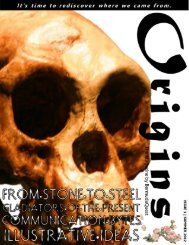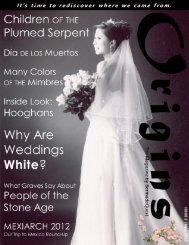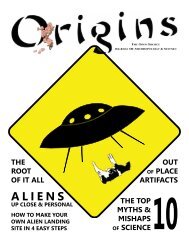Issue 9: Burning History & the Ashing of Science
Why are people so set on defacing and destroying history? What events have occurred up until the present day that made future generations omit the past, both willingly and unwillingly. The story of modern media, the Spanish Inquisition, the Crusades, Alexandria and more!
Why are people so set on defacing and destroying history? What events have occurred up until the present day that made future generations omit the past, both willingly and unwillingly. The story of modern media, the Spanish Inquisition, the Crusades, Alexandria and more!
Create successful ePaper yourself
Turn your PDF publications into a flip-book with our unique Google optimized e-Paper software.
People scrambled about <strong>the</strong> streets <strong>of</strong> Maní as a pyre was prepped in <strong>the</strong> main<br />
square <strong>of</strong> <strong>the</strong> Yucatec town. Codices filled with astronomy, history, math, and religion<br />
were piled up among <strong>the</strong> sculptural “works <strong>of</strong> <strong>the</strong> devil.” A lucky discovery<br />
by <strong>the</strong> Spanish…if <strong>the</strong>y had not found <strong>the</strong> cave, maybe <strong>the</strong> books wouldn’t have<br />
burned. Smoke filled <strong>the</strong> air on July 12, 1562 as Spanish friar Diego de Landa burned<br />
<strong>the</strong> beliefs <strong>of</strong> <strong>the</strong> Maya <strong>of</strong> Maní, thus ending <strong>the</strong> final kingdom <strong>of</strong> <strong>the</strong> Tutul-Xiu.<br />
Diego de Landa (1524-1579) arrived in Yucatán,<br />
Mexico in 1549. In Izamal, a previously important<br />
religious center prior to <strong>the</strong> Spanish arrival,<br />
a Catholic church was built on top <strong>of</strong> <strong>the</strong> old<br />
temples to deracinate Maya idolatry. Those who<br />
refused to renounce <strong>the</strong>ir ancient beliefs and<br />
embrace Catholicism faced Inquisition trials and<br />
many were killed. The inquisition <strong>of</strong> Maní lasted<br />
three months with over 4,000 natives tortured<br />
during conversion trials.<br />
INQUISITION: BURNT BOOKS & PRESERVED POTS | 7<br />
accordion books (or codices). Many pots–including<br />
plates, bowls, jars, cups, and more ceramics<br />
<strong>of</strong> that style–were painted in hieroglyphic texts,<br />
which archaeologists continue to collect and<br />
study today. The Maya wrote on everything. Since<br />
pots were not assumed to be in direct competition<br />
with <strong>the</strong> Holy Bible, <strong>the</strong>y managed to avoid destruction<br />
better than o<strong>the</strong>r hieroglyphic artifacts.<br />
De Landa’s writings have assisted in piecing back<br />
“Hallámosles gran número de libros de estas sus letras, y<br />
porque no tenían cosa en que no hubiese superstición y falsedades<br />
del demonio, se los quemamos todos, lo cual sintieron a<br />
maravilla y les dio mucha pena.” - Diego de Landa<br />
eRelación de las Cosas de Yucatán (117-8)<br />
Diego de Landa’s inflexible and raucous conduct<br />
earned him a trip back to Spain in 1563 after being<br />
condemned by <strong>the</strong> Council <strong>of</strong> <strong>the</strong> Indies. By<br />
1566, he completed his book Relación de las Cosas<br />
de Yucatán (Relation on <strong>the</strong> incidents <strong>of</strong> Yucatan)<br />
to explain his inquisition actions in trial.<br />
On pages 117 and 118, Diego de Landa states:<br />
“We found many books with <strong>the</strong>se letters [hieroglyphs],<br />
and because <strong>the</strong>y contained nothing<br />
that was free from superstition and <strong>the</strong> devil’s<br />
trickery, we burnt <strong>the</strong>m, which <strong>the</strong> Indians greatly<br />
lamented.” In 1573, de Landa returned to Yucatan<br />
as bishop cleared <strong>of</strong> all accusations.<br />
Over 5,000 idols and at least 27 hieroglyphic texts,<br />
assumed to be full <strong>of</strong> witchcraft and evil knowledge<br />
against <strong>the</strong> Catholic church, ashed away into<br />
<strong>the</strong> earth. Luckily, <strong>the</strong> Spanish destroyed almost<br />
exclusively statues, figurines, and <strong>the</strong> bark-paper<br />
toge<strong>the</strong>r burnt history, albeit from a biased perspective.<br />
He wrote <strong>of</strong> <strong>the</strong> calendars, economy,<br />
politics, religion, and social organization. He took<br />
special interest in <strong>the</strong> similarity <strong>of</strong> <strong>the</strong> cross-shape<br />
in Christianity and <strong>the</strong> Maya world tree, as well as<br />
o<strong>the</strong>r similarities between <strong>the</strong> two religious systems.<br />
Yuri Knorozov, Russian scholar, deciphered<br />
<strong>the</strong> glyphs de Landa had written from <strong>the</strong> 1600s<br />
(an attempt to match Spanish sounds with Mayan<br />
glyphs) in 1952. De Landa had believed each<br />
glyph was a single letter like <strong>the</strong> Latin alphabet;<br />
Knorozov figured out <strong>the</strong>y were syllables.<br />
Even with advances in hieroglyphic studies from<br />
architecture, sculptures, and painted pots: to this<br />
day, <strong>the</strong> Mayan code remains incomplete with<br />
undecipherable pieces. The Spanish Inquisition<br />
<strong>of</strong> <strong>the</strong> Americas is an example <strong>of</strong> <strong>the</strong> catastrophic<br />
reality <strong>of</strong> history told by <strong>the</strong> victor. u<br />
Origins Scientific Research Society


















